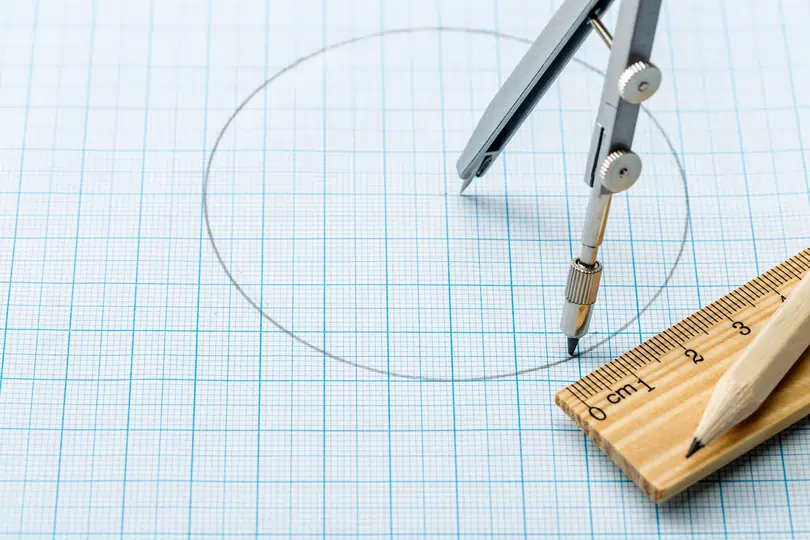Distance, Speed And Time
In this article, we will be learning about various aspects of speed, distance and time according to the P6 mathematics syllabus.
What Is Speed?
It is the distance that we cover in one unit of time. It refers to how fast we travel. Generally, we use ‘kilometre', ‘metre’ or ‘centimetre’ for distance and ‘hour’ or ‘minute’ or ‘second’ for time.
Why do we need to find speed?
Speed is essential so that we can plan our journey. If we know how much time it will take for us to reach a certain place, then we can plan what time we need to leave home to be able to reach that place.
Finding speed
To find the speed of a moving object, we take the distance travelled by the object and divide it by the time it has taken to cover that distance. Thus, the formula for speed is:
\(\bbox[5px, border:2px solid #262262] { \mathrm{Speed = Distance \div Time} }\)
Let us see some examples to understand the concept.
Practice Problems
Question 1:
A car travels \(\text{60 km}\) in \(\text{30 minutes}\). What is the speed of the car?
Solution:
Distance covered by the car \(= \text{60 km}\)
Time taken to cover the distance \(= \text{30 min}\)
Speed of the car\(\begin{align} &= \text{Distance} \div \text{Time}\\[2ex] &=60 \text{ km} \div 30 \text{ min}\\[2ex] &= 2 \text{ km/min} \end{align} \)
Answer :
\(2 \text{ km/min}\)
Question 2:
Arun ran a marathon of \(\text{2 km}\) in \(\text{10 minutes}\). What is his speed?
Leave your answer in \(\text{km/h}\).
Solution:
Distance covered \(= \mathrm{2 \;km}\)
Time taken\(\begin{aligned} &= \mathrm{10 \;min}\\[2ex] &= \mathrm{10 \div 60\;h}\\[2ex] &= \mathrm{\frac {1}{6}h} \end{aligned}\)
Speed\(\begin{align} &= \text{Distance} \div \text{Time}\\[2ex] &= \mathrm{2\;km \div \frac{1}{6}h} \\[2ex] &= \mathrm{(2 \times 6)\;km/h} \\[2ex] &= \mathrm{12 \;km/h} \end{align} \)
Answer :
\(\text{12 km/h}\)
Question 3:
John ran a distance of \(15 \;km\) in \(15 \;min\). Find his speed in \(km/h\).
Solution:
Distance covered (d) \(= 15 \;km\)
Time taken (t) \( =15 \;min\)
Since the speed has to be in \(km/h\), we will first convert the time taken into hours.
\(\begin{align} 15 \text{ min} &=15 \div 60 \text{ h} \\[2ex] &=\frac{1}{4}\text{ h} \end{align}\)
\(\begin{align} \text{Speed} &= \text{Distance} \div \text{Time}\\ &= 15\;km \div \frac{1}{4}h \\ &= (15 \times 4)\;km/h \\ &= 60 \;km/h \end{align} \)
Answer:
\(60 \;km/h\)
Question 4:
Carla started from her home in Town A at \(6.10 \;pm\) and reached her grandparents' home in Town B at \(9.10 \;am\) the next day. The distance between Town A and Town B is \(1200 \;km\). Find the speed at which Carla travelled to reach her destination.
Solution:
Distance between Town A and Town B \(= 1200\;km\)
Time taken to cover the distance \(=\;?\)
Let us calculate the time taken to travel from Town A to Town B.
From \(6.10 \;pm\) to \(6.10 \;am\) \(= 12 \;h\)
From \(6.10 \;am\) to \(9.10 \;am\) \(= 3 \;h\)
Total time taken \(= 12 \;h + 3 \;h \)
\(=15 \;h\)
\(\begin{align} \text{Speed} &= \text{Distance} \div \text{Time} \\ &=1200 \;km \div 15 \;h \\ &=80 \;km/h \end{align}\)
Answer :
\(80 \;km/h\)
Question 5:
Bob ran \(5 \;km\) in \(30 \;minutes\). Calculate his speed in \(km/h\).
Solution:
Distance covered (d) \(= 5\;km\)
Time taken (t) \(=30\;min\)
Since the speed has to be in \(km/h\), we will first convert the time taken into hours.
\(\begin{align} 30 \;min &=30 ÷ 60 \;h\\ &=\frac{1}{2}h \end{align} \)
\(\begin{align} \text{Speed} &= \text{Distance} \div \text{Time} \\ &=5 \;km \div \frac{1}{2} \;h \\ &= (5 \times2) \;km/h \\ &= 10 \;km/h \end{align}\)
Answer:
\(10 \;km/h\)
Finding Time
We know that speed is the distance covered per unit of time.
To find the time taken to cover a particular distance, we take the distance covered by the object divided by the speed of the object,
\(\bbox[5px, border:2px solid #262262] { \text{Time}= \text{Distance} \div \text{Speed} }\)
Let us try to better understand this concept using some examples.
Practice Problems
Question 1:
Ram is running at the speed of \(200 \;m/min\). How long will he take to cover a distance of \(1000 \;m\)?
Solution:
Speed (s) \(= 200 \;m/min\)
Distance (d) \(= 1000 \;m\)
Time (t) \(= \;?\)
\(\begin{align} \text{Time} &= \text{Distance} \div \text{Speed} \\ &= 1000\;m \div 200 \;m/min \\ &= 5 \;min \end{align}\)
Answer:
\(5 \;min\)
Question 2:
A train is travelling at a speed of \(100 \;km/h\). How long will it take to cover a distance of \(325 \;km\)?
Solution:
Speed (s) \(= 100 \;km/h\)
Distance (d) \(= 325 \;km\)
Time (t) \(= \;?\)
\(\begin{align} \textstyle \text{Time} &= \text{Distance} \div \text{Speed} \\ &= 325\;km \div 100 \;km/h \\ &= 3.25 \;h \end{align}\)
Answer:
\(3.25 \;h\)
Question 3:
A train is travelling at a speed of \(100 \;km/h\). How long will it take to cover a distance of \(425 \;km\)?
Solution :
Speed (s) \(= 100 \;km/h\)
Distance (d) \(= 425 \;km\)
Time (t) \(= \;?\)
\(\begin{align} \textstyle \text{Time} &= \text{Distance} \div \text{Speed} \\ &= 425\;km \div 100 \;km/h \\ &= 4.25 \;h \end{align}\)
Answer:
\(4.25 \;h\)
Question 4:
Tom took a bus from Town A to Town B. The bus travelled at a speed of \(\text{60 km/h}\). The distance between the two towns is \(\text{300 km}\). He arrived at Town B at \(\text{3 pm}\). At what time did he leave Town A?
Solution:
Speed (s) \(= \text{60 km/h}\)
Distance (d) \(= \text{300 km}\)
\(\begin{align} \textstyle \text{Time} &= \text{Distance} \div \text{Speed} \\ &= \text{300 km} \div \text{60 km/h} \\ &= \text{5 h } \end{align}\)

He left Town A at \(\text{10 am}\).
Answer:
\(\text{10 am}\)
Question 5:
Krishna drove from Town A to Town B at a speed of \(\text{50 km/h}\). The distance between the two towns was \(\text{500 000 m}\). He arrived at Town B at \(\text{3 pm}\). At what time did he leave Town A?
Solution:
Speed (s) \(= 50 \;km/h\)
Distance (d) \(= 500\,000 \;m\)
Since the speed and distance are in different units, we will first convert the distance from metres to kilometres.
We know,
\(\begin{aligned} \text{1000 m} &= \text{1 km} \\[2ex] \text{500 000 m} &= \text{(500 000} \div \text{1000) km} \\[2ex] &= \text{500 km} \end{aligned}\)
\(\begin{align} \textstyle \text{Time} &= \text{Distance} \div \text{Speed} \\ &= 500\;km \div 50 \;km/h \\ &= 10 \;h \end{align}\)
In the question, it is given that Krishna reached his destination Town B at \(3 \;pm\). From the above, we see that the time taken by him to go from Town A to Town B is \(10 \;h\). Thus, Krishna must leave Town A \(10 \;h\) before \(3 \;pm\).

He left Town A at \(5 \;am\).
Answer:
\(5 \;am\)
Finding Distance
To find the distance travelled, we multiply the speed of the object and the time taken, so equation or formula of distance is
\(\bbox[5px, border:2px solid #262262] { \text{Distance}= \text{Speed} \times \text{Time} }\)
Practice Problems
Question 1:
A car, travelling at \(60 \;km/h\) took \(3 \;h\) to travel from Town X to Town Y. What is the distance between Town X and Town Y?
Solution:
Speed (s) \(=60 \;km/h\)
Time (t) \(=3\;h\)
\(\begin{align} \text{Distance} &= \text{Speed} \times \text{Time} \\ &= 60\;km/h \times 3\;h \\ &= 180\;km \end{align} \)
The distance between Town X and Town Y is \(180 \;km\).
Answer:
\(180 \;km\)
Question 2:
A bus travelling at \(60 \;km/h\) took \(3.5 \;h\) to travel from Town A to Town B. What is the distance between Town A and Town B?
Solution:
Speed (s) \(=60 \;km/h\)
Time (t) \(=3.5\;h\)
\(\begin{align} \text{Distance} &= \text{Speed} \times \text{Time} \\ &= 60\;km/h \times 3.5\;h \\ &= 210\;km \end{align} \)
The distance between Town A and Town B is \(210 \;km\).
Answer:
\(210 \;km\)
Conclusion
In this lesson, we learnt how to find the distance, speed and time.
Let us recap the formulae.
- Speed is the distance covered per unit of time.
- Speed \(=\) Distance ÷ Time
- Time \(=\) Distance ÷ Speed
- Distance \(=\) Speed × Time
Test Yourself
A car travels at 20 m per second. How many kilometers does it travel in 40 minutes?
Ans: (3) 48 km
Ellen jogs 4 km in 20 min. Alex's average speed is 2 km/h slower than Ellen's. What is Alex's average speed?
Ans: (2) 10 km/h
Stella cycled 7 km in 35 minutes. What was her cycling speed in km/h?
Ans: (2) 12
A taxi drove at an average speed of 75 km/h. How long would the driver need to cover a distance of 225 km?
Ans:(3) 3 h
Mr Gavin travelled \(\frac{3}{5}\) of his journey in 40 minutes. He travelled the remaining 80 km in \(1\frac{1}{3}\) h. Find his average speed for the whole journey.
Ans: (3) 100 km/h




 SG
SG  VN
VN 


















